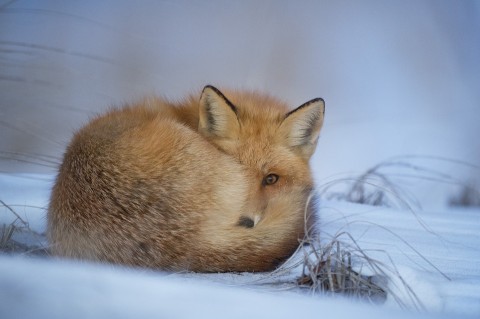
The Thought Fox is a poem composed by the popular English poet Ted Hughes. First published in 1957 as a part of his first collection of poetry “The Hawk in The Rain”, this animal poem is a description of the creative process undertaken by a poet in his work. It is about the creativity and the inspiration that goes into writing poems. The poem starts with the speaker having a blank page on which he is probably trying to compose something and ends with the piece finally filling the sheet which no longer remains blank.
The Thought Fox | Summary
The Thought Fox | Summary, Lines 1-4
I imagine this midnight moment’s forest:
Something else is alive
Beside the clock’s loneliness
And this blank page where my fingers move.
The speaker, most likely the poet himself, sits alone in his study during the night, surrounded by a forest which in all likeliness is a fragment of his imagination. In this state of loneliness and darkness that engulfs him, he feels a presence of some other being besides himself near him. The only things that can be found apart from the speaker are the clock which is ticking away in solitude and a blank sheet on which he is trying to write a poem. But nevertheless, the poet has an inkling that there is something apart from himself that is alive there.
The Thought Fox | Summary, Lines 5-8
Through the window I see no star:
Something more near
Though deeper within darkness
Is entering the loneliness:
Looking out through the window, the speaker does not see any stars in the night sky. But he feels that there is something that is approaching him in his isolated state, coming nearer through the darkness that envelopes the surroundings. It seems like the approaching figure is coming from deep within the darkness of the imaginary forest, trying to breach into the speaker’s state of solitude.
Such silence and solitude are necessary to create an environment that fosters creativity and enables the poet to put his feelings into words.
The Thought Fox | Summary, Lines 9-12
Cold, delicately as the dark snow
A fox’s nose touches twig, leaf;
Two eyes serve a movement, that now
And again now, and now, and now
Since it is the winter season, the entire atmosphere is very cold and dark. The speaker discovers a fox who is softly touching the twigs and leaves with its nose, its action seeming as graceful as the snow. He is looking around again and again, carefully scrutinizing its surroundings and taking in all details. From time to time his eyes seem to scan the environment.
Just like the fox, a poet too sits with a blank piece of paper resembling the snow-covered forest. Before he can compose his piece, he too, like the fox, tries to gauge his surroundings, taking in all that is happening. It is out of this that he comes across the thought that strikes his mind, initiates his creativity and leads to the overflow of passion and emotions that ultimately leads to poetry.
The Thought Fox | Summary, Lines 13-16
Sets neat prints into the snow
Between trees, and warily a lame
Shadow lags by stump and in hollow
Of a body that is bold to come
Making its way between the trees, the fox leaves behind his footprints on the snow. His shadow lags behind him hesitantly, like an injured animal, but his body is brimming with boldness and confidence as he moves in the forest. His movement, unlike its wary shadow, is purposeful and poised, which is also evident from the neatness of his footprints as this could only be achieved by a self-assured and composed stance.
As the poet moves further in his creative process, there are moments when he is filled with doubts and uncertainties, but he manages to overcome it and develops a bold and instinctive stance that lends surety and conviction to his expression.
The Thought Fox | Summary, Lines 17-20
Across clearings, an eye,
A widening deepening greenness,
Brilliantly, concentratedly,
Coming about its own business
The fox’s gaze widens and he looks across the forest clearing which starts to seem greener to his expanded vision. He is engulfed by the brilliancy of what he sees, the vividness and intensity of the colours, and thus mesmerised, he now puts all his focus to what lays ahead. His eyes are now solely concentrated on creating his own vision of the sight that his eyes see.
This is the part of the creative process when the poet puts into his own words what he witnesses around him and lends it the originality of thought and perception. Finally discovering the thought that shall illuminate his words, the poet is now ready for the next step in the process.
The Thought Fox | Summary, Lines 21-24
Till, with a sudden sharp hot stink of fox
It enters the dark hole of the head.
The window is starless still; the clock ticks,
The page is printed.
Finally, the fox now seems to enter the poet’s head, merging into his subconscious so that both this creature and the mind of the poet are now one. They have both reached the climax of the creative process. The scent of the fox engulfs the poet’s senses, filling the ‘dark hole’ in his head, blending with his own instincts.
The poet now turns his attention back to the real world, finding that no change has occurred in his physical surroundings. The night is still starless and the clock is still ticking- yet, something inside of him has changed, having undergone a complete transformation which can be seen on the blank sheet of paper which is now printed with his words. The creative process has thus culminated and the sheet now bears the poetry of his heart.
The Thought Fox | Analysis
“The Thought Fox” is an example of meta-poetry, ie. poetry that deals with the subject of poetry.
It uses the fox as an extended metaphor for the creative process, and the imagination and thought that goes behind a piece of poetry. This creative thought, like the fox coming out of the dark woods, emanates from an unknown place inside the writer’s subconscious which is far removed from his conscious mind. The poet, through the vivid portrayal of the fox and his movements, manages to paint a picture of the flow of creativity that leads to the creation of poetry. Through his treatment of the fox, he brings to life the power of poetry and the way in which the written word can bring an entirely new world to life.
Creativity, inspiration and imagination are the central themes of this poem which are depicted through the mysterious, unpredictable yet careful movements of the fox. The poet also shows that patience and concentration, combined with instinct, are the prerequisites for bringing a poem to existence. Writing requires focus and stillness akin to the fox who is on the lookout for his prey. Like him, the writer has to single-mindedly focus on his task, doing away with all other distractions of his surroundings. Also, just as the prey is not in control of the fox, so is the mysterious force of the creative inspiration that arises out of the poet’s unconscious and is beyond the control of his conscious mind.
The Thought Fox | Form and Tone
The poem is composed of 24 lines, divided into 6 quatrains.
It is free flowing, without any particular rhyme scheme, and is written in the blank verse. The tone is pensive and has a tinge of loneliness. The structure is somewhat circular as the poem ends with the same images of the clock, the starless sky as seen from the window and the sheet of paper, with which it began.
The Thought Fox | Literary Devices
The forest in the first stanza is a metaphor for the unconscious mind of the poet which is as mysterious as the dark forest. In the same stanza, clock has been personified as lonely.
Repetition of ‘now’ is skilfully used in the third stanza to describe the movement of the fox. There is also a repetition of various symbols such as the window, the clock, the sheet of paper, the darkness of the forest and the cold, which serves to emphasize the central idea of the poem.
Imagery is intense and vivid throughout the poem.
Simile is used in line 9 (cold, delicately as the dark snow) to compare the gentle movement of the fox to the delicate snow.
In line 11, ‘two eyes’ work as metonymy for the fox.
The “clock ticks” in line 23 is an example of onomatopoeia.
Alliteration has been employed in various places across the poem such as in line 1 (midnight moment’s), line 10 (touches twig), line 16 (body that is bold) and line 24 (page is printed). There are also multiple instances where assonance and consonance have been used.

